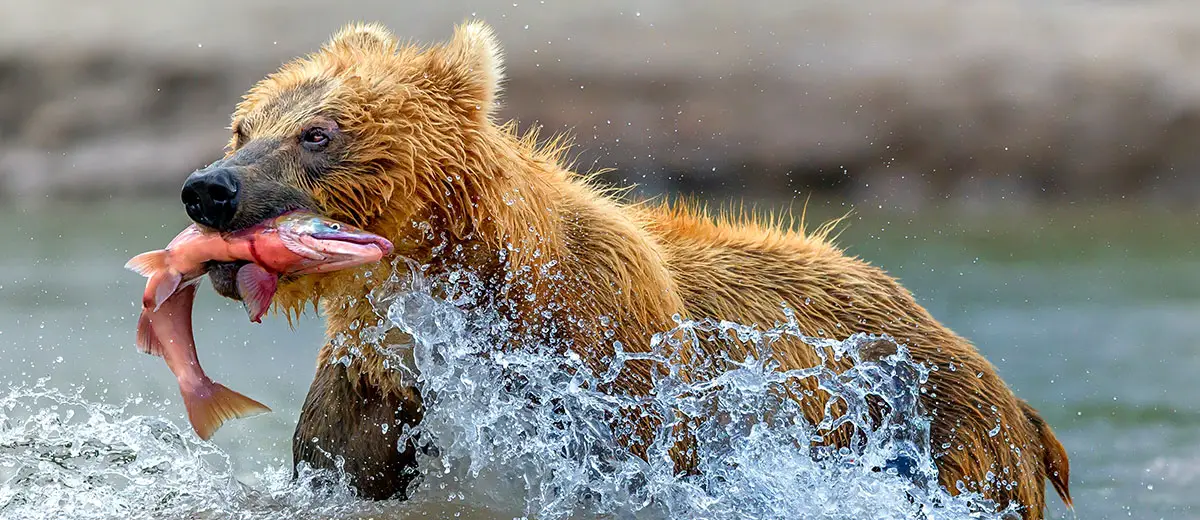Where to See Bears | A Worldwide Guide With Every Species
From the northern wilderness of the Arctic to the southern tip of the Andes Mountains and the jungles of Borneo, collectively, the eight species of bear occupy a surprisingly large range spanning four continents. Most bears live in thickly vegetated terrain where plant matter such as berries, roots and leaves are plentiful, with those who have access to meats like salmon on a regular basis being considerably larger than their insect preying cousins. There are, of course, a few standalone bucket list experiences for any bear enthusiast, however, when comparing the ranges of each species of bear, there are several locations where one can see multiple species in the same trip. Whether you choose to visit brown bears in Alaska or the much smaller sloth bear in Asia, which is actually notoriously aggressive, please exercise extreme caution in bear country. It is often much safer to hire an experienced guide, widely available in most of the national parks you’ll visit, who can ensure the safety of not only yourselves but the bears too.
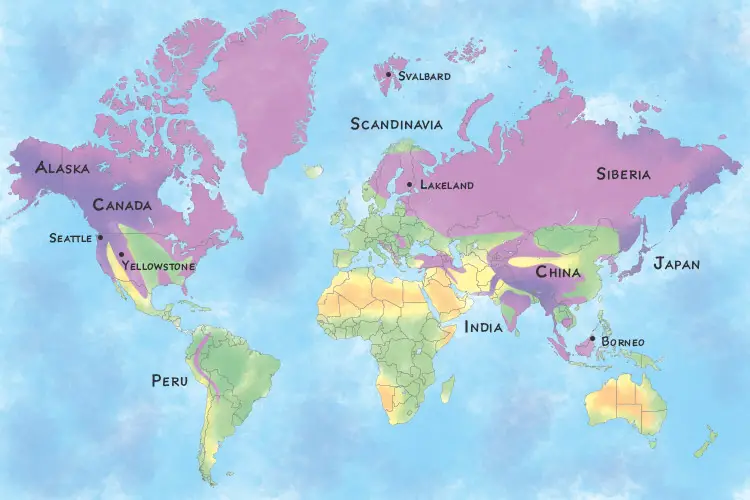
India
Surprised? I was too! India is one of only two countries I could find that is home to four species of bear. The huge Himalayan brown bear and the Asiatic black bear can be found at the foothills of the Himalayas in India’s northernmost provinces, sun bears are residents of India’s far eastern provinces and the sloth bear is found throughout most of the country. In addition to the unrivalled variety of bear species, India is also home to tigers, elephants, rhinoceroses, leopards, the list goes on. If I had to pick one country to visit in search of wildlife, India would be it. The only down-side to bear watching here, which may be a huge upside, is organised tours are far less available, for brown & black bears at least, making it much less reliable to see these animals. Here’s an example.
Himalayan brown bears in Dras, Jammu & Kashmir
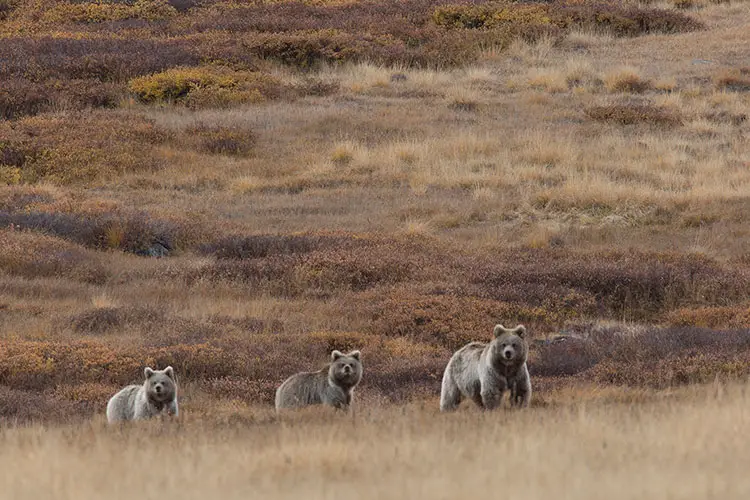
A critically endangered subspecies, the Himalayan brown bear is found throughout the mountainous regions of central Asia including Afghanistan, Pakistan, India and Nepal. Their numbers in the wild are declining due to habitat loss and it is estimated there are around 500-1000 left in the northern states of India. This article from the South China Morning Post details an expedition into northern India to track down this elusive creature and, if like me, you struggle to purge adventure and wildlife from the forefront of your mind, tracking down the Himalayan brown bear in India should be at the top of your bucket list.
Sloth Bears in Satpura National Park
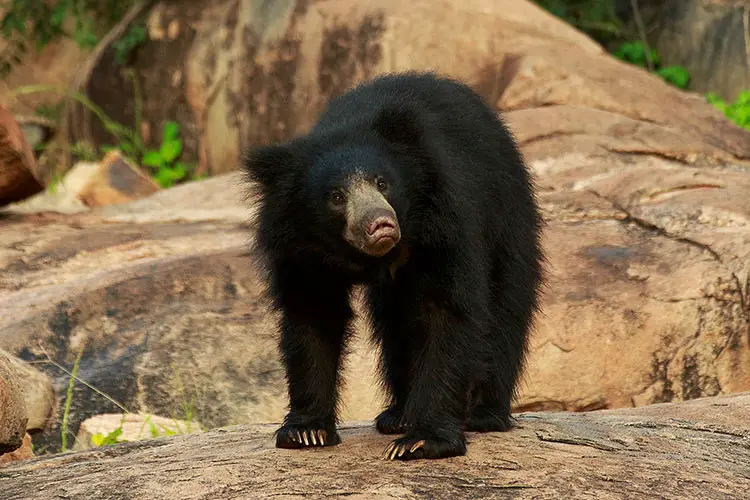
A significantly easier feat to achieve than our first Indian adventure, sloth bear sightings in the centrally located Satpura National Park are common and the experience is coupled with the opportunity to see tigers up close alongside spotted deer, Indian bison and much more. Sloth bears are unique in their appearance, exhibiting long snouts and tongues, which they use to annihilate termite mounds, and are covered in long shaggy fur. If you’re looking for a more intimate experience without herds of safari jeeps, being much less-known than larger parks like Ranthambore, this is one national park you’ll want to visit. Satpura can be reached by road, train or air and there is a selection of lodges close to the park gate, all listed on the park’s website.
Canada
Home to 3 species and a variety of subspecies, visitors to The Great White North are treated to several unique experiences you won’t find anywhere else in the world. Canada is also one of the most enjoyable countries to visit, with famously friendly locals, excellent amenities and a reliable road network, you could easily spend a whole summer travelling this region in search of bears. British Columbia and Alberta are by far the most widely recognised bear watching destinations in Canada and, due to its proximity to the Arctic circle, Manitoba is also a must-hit province for one of the most Canadian experiences you could wish for.
Spirit Bears in the Great Bear Rainforest, British Columbia
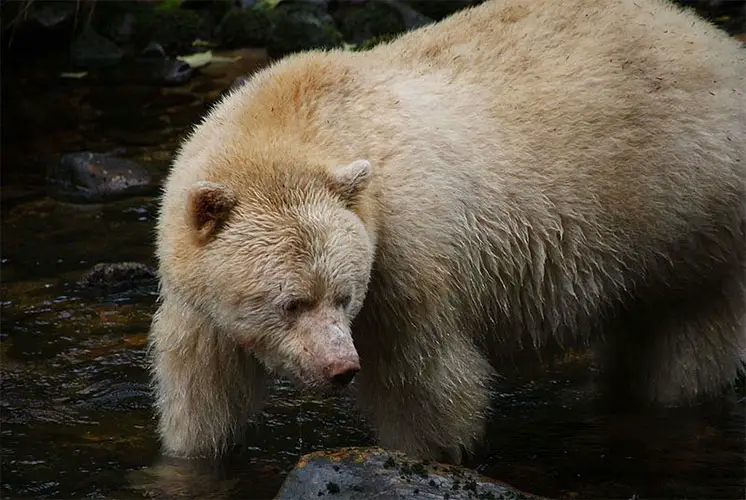
In addition to being prime Grizzly territory, the central coast of British Columbia is home to one of the most magical-looking creatures on the planet, the Spirit Bear. These light-furred animals represent around 10% of the population of Kermode bears, a subspecies of black bear, and are only found in the Great Bear Rainforest of coastal northwestern British Columbia. The bear watching season here is closely linked to the salmon run that starts around the end of August. Due to the remoteness of this location, there are limited tour options, however, this does come with a distinct advantage. Unlike more popular and accessible destinations, group sizes are limited and tour options include boat, hiking and kayaking, check out Spirit Bear lodge for more information.
Polar Bears in Churchill, Manitoba
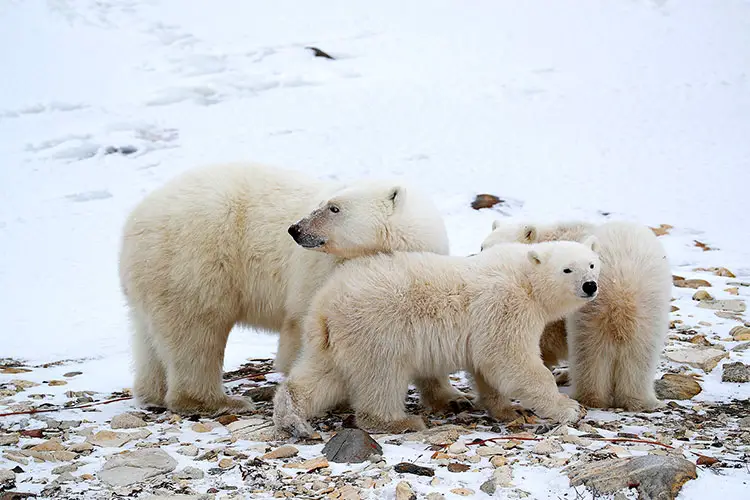
Polar bears are the largest species of bear weighing upwards of 600 kg (1,320 lbs), feeding mostly on seals, they are found solely in the arctic circle. Churchill has developed a reputation as one of the few stellar destinations to see these majestic creatures in their natural surroundings. It is not possible to drive to Churchill so the easiest way to get there is flying from Manitoba’s capital, Winnipeg. The best time to see polar bears is between July to November with the latter two months being the best time to see them in a snowy setting. Options include both vehicular tours in gigantic arctic-ready buses or for the brave, walking tours are also an option, yikes! It is also possible to spot a collection of other snow-white animals including arctic foxes, snowy owls and beluga whales. The best time to see these other animals varies so be sure to check out Travel Manitoba’s website if there is something specific you’d like to see. In addition to the array of fauna, Churchill offers several once in a lifetime experiences including dog sledding and the northern lights, which are best viewed between January and March.
Alaska
Also home to 3 species of bear, of all the locations listed in this article, Alaska has the most subspecies including the largest brown bear, the Kodiak bear, which comes in a close second overall to the polar bear. Prime territory for brown bears (commonly referred to as Grizzly bears in North America) black bears and polar bears, Alaska is probably the most famous bear watching destination on the planet for a good reason. This state is vast and difficult to navigate so unless you’re driving up from Canada, Ted Stevens Anchorage International Airport will serve as your entry point into Alaska and your stopover before flying to either of the below-mentioned destinations.
Grizzly Bears Salmon Fishing at Brooks Falls
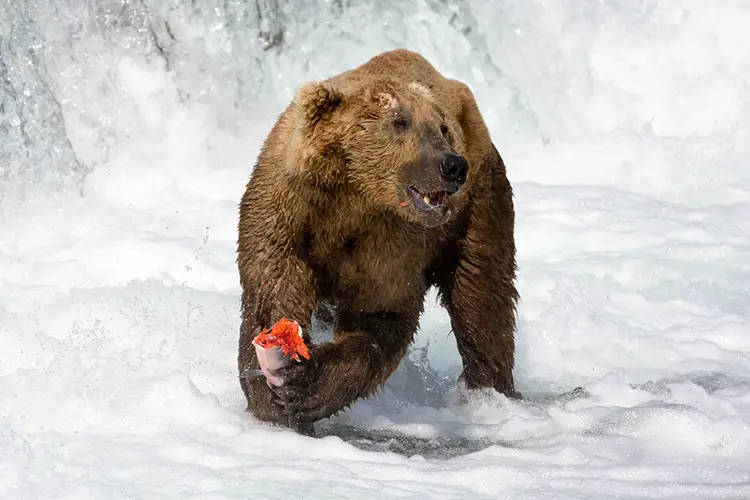
If your goal is capturing these impressive mammals on film, there is no better setting than Brooks Falls during salmon migration. Brooks Falls sits on the eastern side of Katmai National Park, around 450 kilometres south-west of Anchorage, as the bird flies. Bear watching season runs from the start of June through to mid-September and there are several options for both transportation and accommodation. The easiest way to get there is to fly from Anchorage to King Salmon Airport and from there, either take a water taxi (which sounds amazing!) or water plane, which is more common if you’re staying at a lodge. Check out recreation.gov, which has more information on camping in Katmai and the permits you’ll need to do so.
Kodiak Bears on Kodiak Island
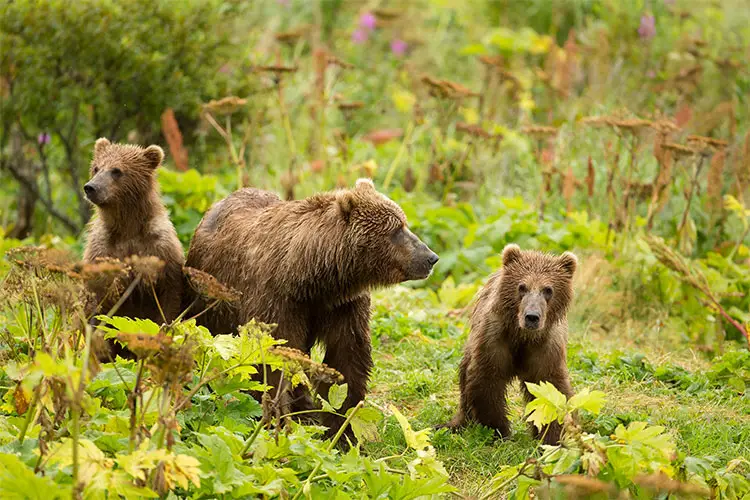
The Kodiak Archipelago sits across the 40-kilometre-wide Shelikof Strait from Katmai National Park and is home to the largest species of brown bear on the planet, weighing up to 600 kg (1,320 lbs). The island’s main city, Kodiak will be the base for your adventure, with flights available directly from Anchorage or from King Salmon, if you’re visiting Brooks Falls beforehand. This is another excellent location to see bears fishing for salmon in one of the area’s many rivers. Options include staying at one of the island’s lodges, taking a tour directly from Kodiak or renting a car and driving around the island. Alaska.org is a great resource for bear watching in this area.
Scandinavia
If it wasn’t for the Spirit bear and Canada being so awesome, Scandinavia would have ranked higher on this list (sorry, Scandinavia) with Norway, logistically speaking, being one of the easier countries in which to see polar bears. This famously happy group of countries also has a thriving brown bear population which is found mostly in northern Sweden and Finland. Similar to Canada, Scandinavia is also famed for its ease of travel, friendly locals and a wide range of activities including sleeping under the northern lights in a glass igloo and visiting Lapland!
Polar Bears in Svalbard, Norway
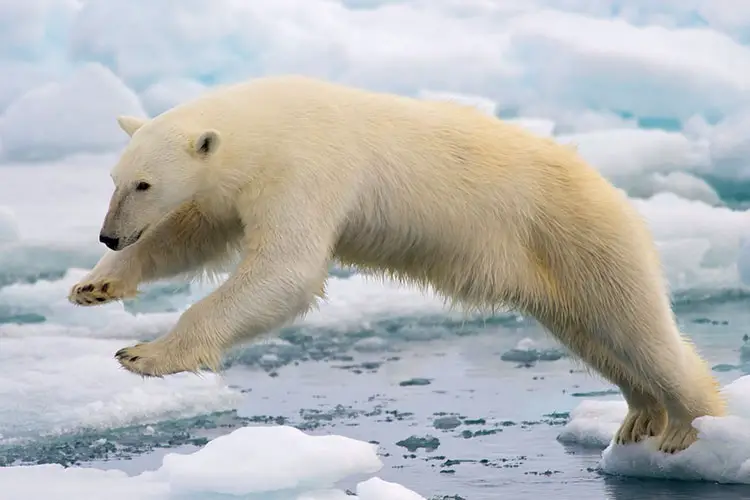
If you’re looking for an adventurous option in your quest to see polar bears, Svalbard is definitely a better choice than Churchill. A little more remote than its Canadian counterpart, Svalbard is a 3-hour flight from Norway’s capital, Oslo. You might think, given its location, that Svalbard would be relatively inhospitable but that couldn’t be further from the truth. Check out the Visit Svalbard website for an array of incredible restaurants, hotels, lodges, guest houses and activities such as horseback riding and dog sledding. There are more polar bears on the Svalbard archipelago than there are people and these animals are highly revered and protected. As such, there are no vehicular safaris in Svalbard and most of the sightseeing is done by boat and hiking, which, in my mind, further cements Svalbard as the adventurous and intimate option. It is also worth noting that Svalbard is plunged into darkness during the winter months so typically May to September is the best time to see polar bears here.
Eurasian brown bears in Lakeland, Finland
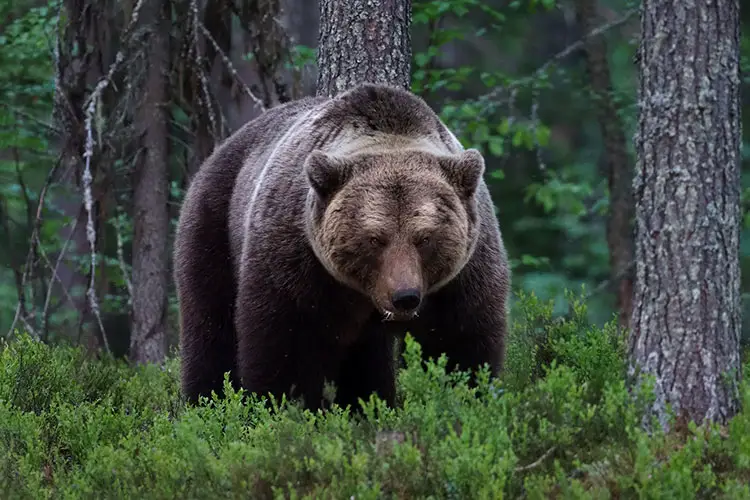
Smaller in size than their North American relatives, Eurasian brown bears are nonetheless enthralling and a visit to Finland’s Lakeland is a tranquil experience. Due to the remoteness of the region and the difficulty of access, it is recommended to take a guided tour, provided by one of the many companies you can find on the Visit Finland website. There is a larger time window here for bear watching with sightings as early as April through the summer months and up to September. Most of the bear watching here is done from huts or hides and there are many supplementary activities like cycling, snowshoeing and history tours.
The American Northwest
It would be impossible to write an article on bear watching without including the home of Yogi (the bear). Grizzly habitat follows the Rockies Mountain Range down into mainland America and this region is also famous for its cinnamon bears, a subspecies of black bear whose fur has a red-brown hue. America’s national park system is one of the best in the world and the variety of wildlife one can see there is astounding. If you haven’t watched it, I highly recommend checking out this short video, which details how the reintroduction of wolves into Yellowstone National Park changed the entire ecosystem and ultimately the course of the park’s rivers.
Cinnamon bears in Yellowstone National Park
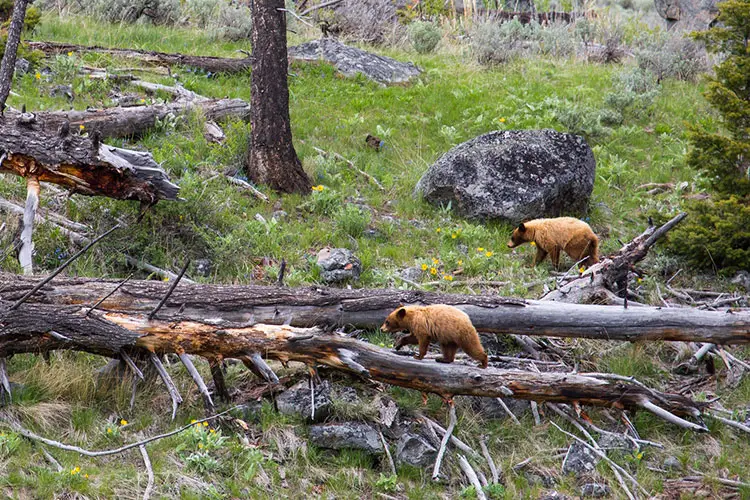
The vast majority of Yellowstone, around 96%, lies in northwest Wyoming although its boundaries extend into Montana and Idaho as well. This UNESCO World Heritage Site sits in the heart of the American Rockies and features spectacular mountainous peaks, a Grand Canyon and vast swaths of forest, the perfect habitat for bears. On the Yellowstone Park website, the Lamar and Hayden Valleys are mentioned constantly as the best place to view black bears, Grizzly bears, wolves, bison, elk, moose and lots more. The Lamar Valley lies along the NE Entrance Road in the north of the park and the Hayden valley lies further south along the Grand Loop Road, which terminates at the northernmost tip of Yellowstone Lake. Your best chance of seeing a cinnamon bear is in the spring when they search for shrubs and shoots before retreating to higher elevations later in the season.
Olympic black bear in Olympic National Park, Washington
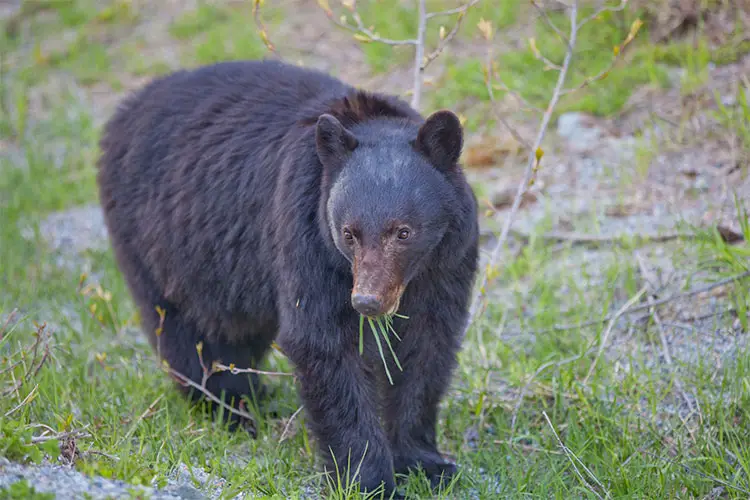
This unique coastal national park is found at the very northwest tip of the American mainland, around 20km south across the Salish Sea from Vancouver Island. This park represents the centre of the Olympic black bear’s territory, which stretches from the middle of British Columbia down to northern California. The coastal environment here is much different to that of Yellowstone and is quite beautiful, with tall moss-covered trees, high alpine vistas and a long, rugged coastline. The best chance to see a black bear in this region is around dawn and dusk in the spring and summer months. Another wildlife experience that would be a shame to miss is whale watching, in particular, Orcas, the Visit Seattle website lists multiple tour operators with some offering a complimentary tour should you not see one, which just goes to show how common they are in these waters.
China
Like India, China is also home to four species of bear with panda bears taking the place of sloth bears, although organised bear watching tours are even less commonplace in this part of the world. If you’re in search of brown, black and even sun bears, there are far better places to see them. Pandas, on the other hand, are endemic to China and only possible to see in zoos outside of the country. Estimates show around 1600 pandas live in the wild in China, most are located in the mountainous regions of the Sichuan province. Pandas are an important symbol to China, famously being used as a diplomatic tool in the 70s and early 80s, and there are several government-owned nature reserves dedicated to the preservation of this species.
Panda Bear in Wolong National Nature Reserve
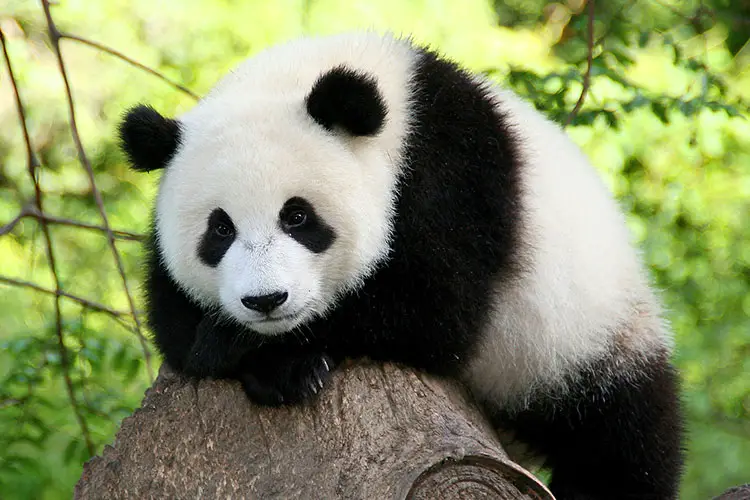
Unfortunately, pandas are notoriously difficult to spot in the wild, however, should you wish to try, Wolong National Nature Reserve is one of the best places to see them and is also home to one of the aforementioned facilities, which could act as your backup. There are several tour companies that offer guided hikes including China Highlights who tout Wolong as being a more intimate experience than some of the larger centres like Chengdu. Wolong lies around a 2-3 hours drive north-west of Chengdu, so you may want to take the time to explore both centres while you’re there.
Japan
Yet another excuse to visit this wonderful country! Japan is home to two species of bear, Ussuri brown bears are found on the island of Hokkaido and the Japanese black bear, a subspecies of the Asiatic black bear, are found throughout much of the country’s main island, Honshu. Aside from being the easiest place to lay eyes on Ussuri browns, Japan is a joy to travel in with its famously efficient transportation system, rich culture and delectable cuisine. If you’re travelling to Japan to see bears it’s well worth exploring Tokyo for a few days and stopping off at one of the country’s many onsens (hot springs) on your way up to Hokkaido.
Ussuri brown bear in Shiretoko National Park, Hokkaido
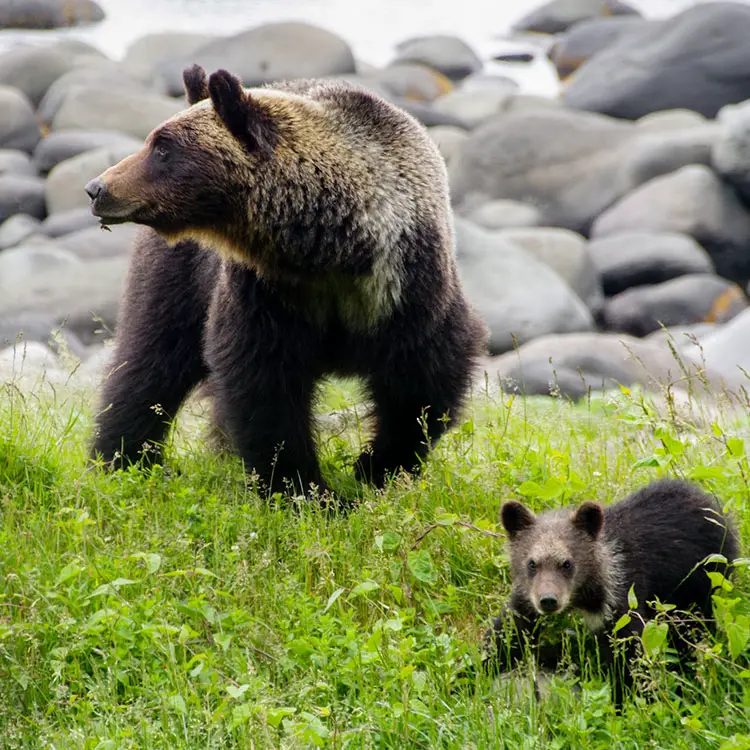
There are several spectacular national parks on the island of Hokkaido including the remote Shiretoko in the north, which was listed as a UNESCO World Heritage Site in 2005 and is one of the most densely populated areas for brown bears in the world. There are several options for bear watching in Shiretoko including hiking and boat tours and much like any of the other locations for brown bears, spring through to late summer is the best time to see them. Mitsuki Matsuda, the Director of Shiretoko Nature Office, wrote an excellent article on the Visit Hokkaido website that provides much more information.
Eastern Russia
Granted, Siberia is not the first destination you might think of when planning a trip! But if you bear in mind (pun intended) this desolate landscape is home to some of the largest brown bears on the planet, polar bears and the Siberian tiger, the thought of spending your hard-earned vacation in Siberia becomes all the more appealing. The province of Siberia is separated from the rest of Russia by the Ural mountain range and occupies almost 80% of Russia’s territory. In addition to its impressive wildlife, Siberia is the home of Lake Baikal, the largest freshwater lake in the world, and the Trans Siberian Railroad.
Kamchatka brown bear, Kamchatka, Siberia
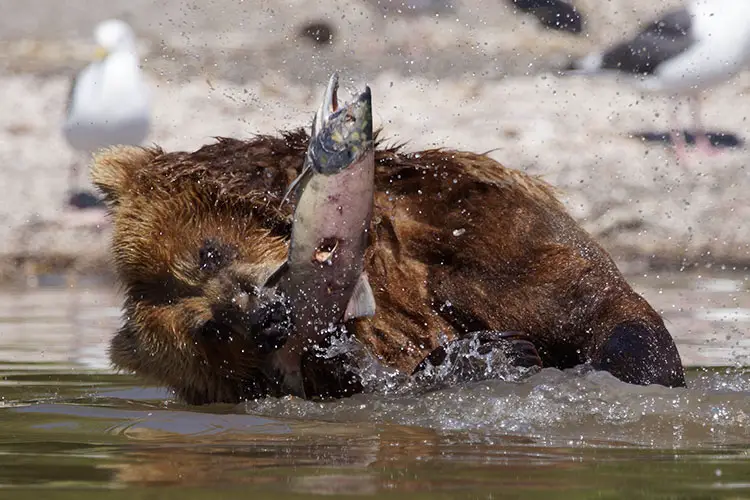
Aside from Alaska, Kamchatka represents one of the best places to see bears fishing for salmon, the abundance of this fish being the primary reason Kamchatka brown bears are so large. The most practical way to get to Kamchatka is to fly into the capital, Petropavlovsk-Kamchatsky which houses the largest airport on the peninsular. One of the most common locations for bear watching is Kuril Lake, which lies on the southern tip, several hundred kilometres south of Petropavlovsk-Kamchatsky. Just a heads up, this isn’t the easiest place to get to! You could attempt to drive overland in a 4×4 if you want to do it on your own but a much more practical way is to take an organised tour by one of the many tour providers in the area.
Southeast Asia
This region of Asia famous for its dense jungle biome is home to two species of bear, the aforementioned Asiatic black bear and the rather odd-looking sun bear (sorry, sun bears!), the smallest of all the bear species. This species is split into two subspecies, the Malayan sun bear, which is found throughout much of mainland Southeast Asia and the Borneo sun bear, which is native to Borneo, a large island split between Indonesia, Malaysia and Brunei. Due to the warm climate then inhabit, sun bears do not hibernate and are mostly nocturnal, making them quite hard to see in the wild. Much like the Andean black bear, this species is classed as vulnerable and one of the best places to see them is a conservation centre in Malaysian Borneo.
Sun Bears at the Bornean Sun Bear Conservation Centre
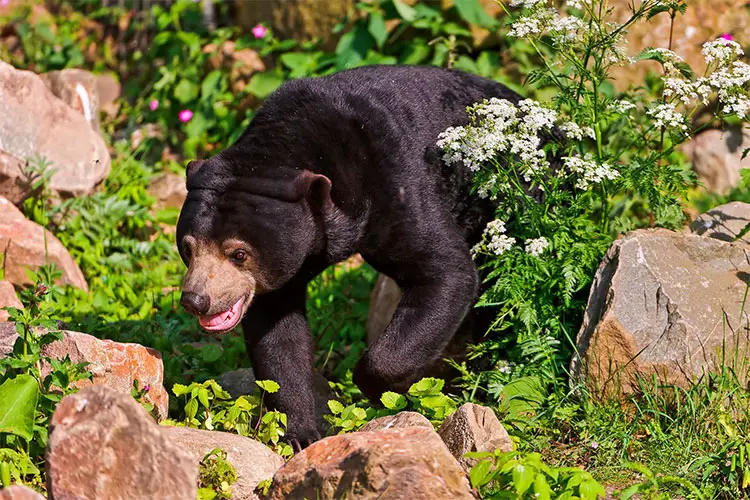
Sepilok is home to both the Bornean Sun Bear Conservation Centre and the Sepilok Orangutan Rehabilitation Centre, which would be a shame to miss if you’re making the journey. Unfortunately, sun bears are becoming increasingly more at risk with poaching being common in much of Southeast Asia and a reduction in habitat thanks to the degradation of the forests they inhabit. This conservation centre specialises in rehabilitating young Sun bears and releasing them back into the wild. It is common to fly into Sabah airport and then take a bus to Sepilok, more information can be found on the Conservation Centre’s website.
South America
This continent contains only one species of bear, the Andean black bear, known as the Spectacled bear for the areas of black and white fur around its muzzle and eyes. The range of the Spectacled bear includes Venezuela, Columbia, Ecuador, Peru, Bolivia and a small amount in northern Argentina. Most famously, Paddington Bear, created by Michael Bond, is a spectacled bear from “Darkest Peru” who arrives in England as a stowaway and is found at Paddington Station, hence the name. While it is possible to see the Andean black bear in other countries it seems only fair to cover lovable Paddington’s home state.
Spectacled Bears in Chaparri Eco-Reserve, Peru
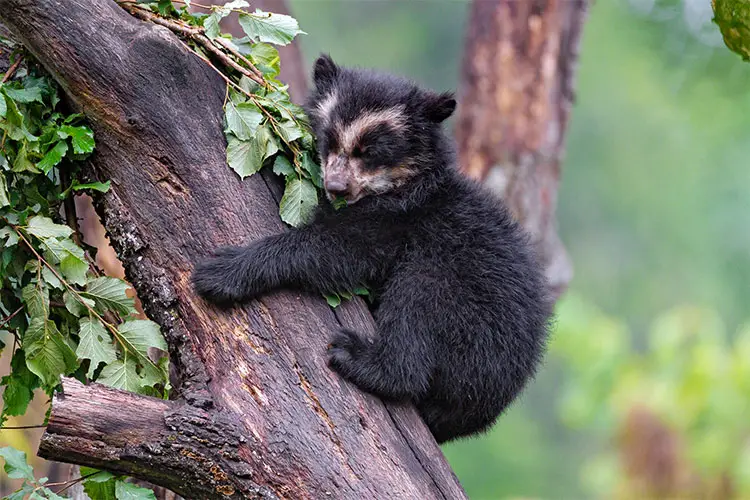
This relatively small reserve sits at the foothills of the Andes in northern Peru, only a few hundred kilometres from the Ecuadorian border. This eco-reserve contains not only a wild population of bears but also the Spectacled Bear Rescue Centre, dedicated to the preservation of this vulnerable species. If you would like to find out more, you can read about their conservation efforts and on their website, which also contains some fantastic imagery of the bears. Andean bears don’t hibernate which gives you a much wider range for viewing with September being the best month after the wet season.
